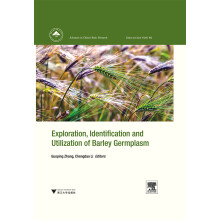大麦种质资源创新与利用

目 录内容简介
1 Domestication and Improvement of Cultivated Barley
1.1 Origin and Domestication of Barley
1.2 Distribution and Growth Habitats of Wild Barley
1.3 Environmental Adaptation of Wild Barley
1.4 Utilization of Wild Barley in Breeding
References
2 Malting Barley Quality Improvement and Germplasm Utilization
2.1 Introduction
2.2 Germplasm Foundation for Two-Row Malting
2.3 Screening for Malting Quality
2.4 Integration of Markers into Screening for Malting Quality
2.5 Scald Resistance Marker Development and Utilization
2.6 Utilization of Some Barley Germplasm
2.7 Germplasm and the Future
References
3 Food Barley Quality Improvement and Germplasm Utilization
3.1 A Brief History of Barley Foods
3.2 The Renaissance of Barley Foods in Western Culture
3.3 The Oregon State University Case Study
3.4 Products: a Decision to Embrace a Whole-Grain Rather than an "Extractive" Model
3.5 Product Development
3.6 Quality Evaluations
3.7 Beyond Streaker
3.8 Conclusions
Acknowledgments
References
4 Exploration and Utilization of Salt-Tolerant Barley Germplasm
4.1 Introduction
4.2 Physiologic Responses of Barley to Salt Stress
4.3 Methodologies for Studying Mechanisms of Salt Tolerance in Barley
4.4 Exploration and Utilization of Salt-Tolerant Barley Germplasm
References
5 Exploration and Utilization of Drought-Tolerant Barley Germplasm
5.1 Introduction
5.2 Drought Tolerance Assessment
5.3 Physiological Bases for Drought Tolerance in Barley
5.4 Genetics and Mechanisms of Drought Stress Tolerance in Barley
5.5 Exploration and Utilization of Drought-Tolerant Barley Germplasm
References
6 Exploration and Utilization of Waterlogging-Tolerant Barley Germplasm
6.2 Introduction
6.2 Adverse Effects of Waterlogging or Submergence Stress
6.3 Morphological Strategies for Low-Oxygen Environment
6.4 Molecular Mechanisms
6.5 Metabolism and Signalling Network in Response to Waterlogging and Submergence
6.6 Exploration and Utilization of Barley Genetic Germplasm with High Waterlogging Tolerance
References
7 Exploration and Utilization of Aluminum-Tolerant Barley Germplasm
7.1 Introduction
7.2 Physiological Responses of Barley to Aluminum Stress
7.3 Mechanisms and Genetics oral Toxicity Tolerance in Barley
7.4 Exploration and Utilization of Aluminum-Tolerant Barley Germplasm
References
8 Frost Tolerance and Genetic Improvement in Barley
8.1 Introduction
8.2 Environments
8.3 Frost Management
8.4 Methods of Screening
8.5 Genotypic Variation for Frost Tolerance in Barley
8.6 Genetic Factors Associated with Frost Tolerance in Barley
8.7 Summary
References
9 Exploration and Utilization of Genetic Diversity Exotic Germplasm for Barley Improvement
9.1 Overview of Barley Origin
9.2 Genetic Diversity in Barley
9.3 Barley Uses
9.4 Yield-Limiting Factors in Barley
9.5 Exotic Barley Germplasm for Improvement
9.6 Exploring Barley Genetic Resources
9.7 What Limits Use of Exotic Barley Germplasm in Breeding Programs?
9.8 Summary
References
10 Improvement of Yield and Adaptation by Manipulating Phenology Genes
10.1 Introduction
10.2 Barley Development and Physiological Determinants of Yield
10.3 Control of Barley Development
10.4 Phenology and Adaptation: Matching Crop Phenology to Growing Conditions in Australia
10.5 Manipulating Developmental Phases for Further Yield Improvement
10.6 Conclusions References
11 Next-Generation Sequencing Technology: Implications for Barley Genetics and Breeding
11.1 Introduction
11.2 Barley Genome Sequencing Projects
11.3 Next-Generation Sequencing Technology
11.4 Next-Generation Sequencing Applications
11.5 Conclusions
References
Index
1.1 Origin and Domestication of Barley
1.2 Distribution and Growth Habitats of Wild Barley
1.3 Environmental Adaptation of Wild Barley
1.4 Utilization of Wild Barley in Breeding
References
2 Malting Barley Quality Improvement and Germplasm Utilization
2.1 Introduction
2.2 Germplasm Foundation for Two-Row Malting
2.3 Screening for Malting Quality
2.4 Integration of Markers into Screening for Malting Quality
2.5 Scald Resistance Marker Development and Utilization
2.6 Utilization of Some Barley Germplasm
2.7 Germplasm and the Future
References
3 Food Barley Quality Improvement and Germplasm Utilization
3.1 A Brief History of Barley Foods
3.2 The Renaissance of Barley Foods in Western Culture
3.3 The Oregon State University Case Study
3.4 Products: a Decision to Embrace a Whole-Grain Rather than an "Extractive" Model
3.5 Product Development
3.6 Quality Evaluations
3.7 Beyond Streaker
3.8 Conclusions
Acknowledgments
References
4 Exploration and Utilization of Salt-Tolerant Barley Germplasm
4.1 Introduction
4.2 Physiologic Responses of Barley to Salt Stress
4.3 Methodologies for Studying Mechanisms of Salt Tolerance in Barley
4.4 Exploration and Utilization of Salt-Tolerant Barley Germplasm
References
5 Exploration and Utilization of Drought-Tolerant Barley Germplasm
5.1 Introduction
5.2 Drought Tolerance Assessment
5.3 Physiological Bases for Drought Tolerance in Barley
5.4 Genetics and Mechanisms of Drought Stress Tolerance in Barley
5.5 Exploration and Utilization of Drought-Tolerant Barley Germplasm
References
6 Exploration and Utilization of Waterlogging-Tolerant Barley Germplasm
6.2 Introduction
6.2 Adverse Effects of Waterlogging or Submergence Stress
6.3 Morphological Strategies for Low-Oxygen Environment
6.4 Molecular Mechanisms
6.5 Metabolism and Signalling Network in Response to Waterlogging and Submergence
6.6 Exploration and Utilization of Barley Genetic Germplasm with High Waterlogging Tolerance
References
7 Exploration and Utilization of Aluminum-Tolerant Barley Germplasm
7.1 Introduction
7.2 Physiological Responses of Barley to Aluminum Stress
7.3 Mechanisms and Genetics oral Toxicity Tolerance in Barley
7.4 Exploration and Utilization of Aluminum-Tolerant Barley Germplasm
References
8 Frost Tolerance and Genetic Improvement in Barley
8.1 Introduction
8.2 Environments
8.3 Frost Management
8.4 Methods of Screening
8.5 Genotypic Variation for Frost Tolerance in Barley
8.6 Genetic Factors Associated with Frost Tolerance in Barley
8.7 Summary
References
9 Exploration and Utilization of Genetic Diversity Exotic Germplasm for Barley Improvement
9.1 Overview of Barley Origin
9.2 Genetic Diversity in Barley
9.3 Barley Uses
9.4 Yield-Limiting Factors in Barley
9.5 Exotic Barley Germplasm for Improvement
9.6 Exploring Barley Genetic Resources
9.7 What Limits Use of Exotic Barley Germplasm in Breeding Programs?
9.8 Summary
References
10 Improvement of Yield and Adaptation by Manipulating Phenology Genes
10.1 Introduction
10.2 Barley Development and Physiological Determinants of Yield
10.3 Control of Barley Development
10.4 Phenology and Adaptation: Matching Crop Phenology to Growing Conditions in Australia
10.5 Manipulating Developmental Phases for Further Yield Improvement
10.6 Conclusions References
11 Next-Generation Sequencing Technology: Implications for Barley Genetics and Breeding
11.1 Introduction
11.2 Barley Genome Sequencing Projects
11.3 Next-Generation Sequencing Technology
11.4 Next-Generation Sequencing Applications
11.5 Conclusions
References
Index
目 录内容简介
张国平、李承道编著的《大麦种质资源创新与利用(英文版)(精)》系统介绍了大麦种质资源研究的新进展,详细介绍了食品大麦和啤酒大麦品质的提高与种质利用;重点介绍大麦非生物胁迫的耐受性研究的新研究,包括干旱、盐性和铝毒性酸性土壤、洪涝及霜冻等;还介绍了基因测序技术及其潜在的应用的新进展,包括提高产量和以及改良环境耐候性基因的技术等;特别介绍了具有更多遗传多样性及更高非生物胁迫耐受性的野生大麦(如我国西藏野生大麦),为大麦育种相关研究者提供了重要的参考资料。
比价列表价格走势
公众号、微信群
 缺书网
缺书网微信公众号
 扫码进群
扫码进群实时获取购书优惠






